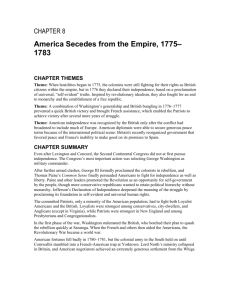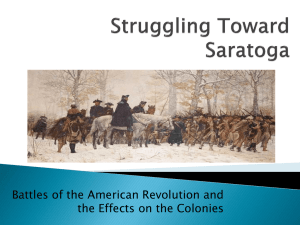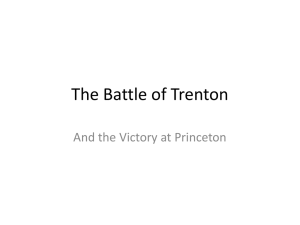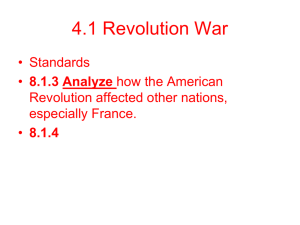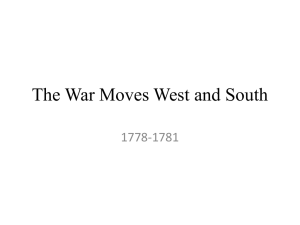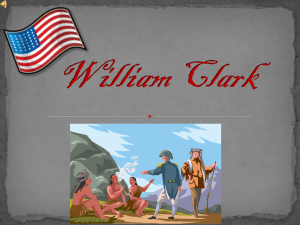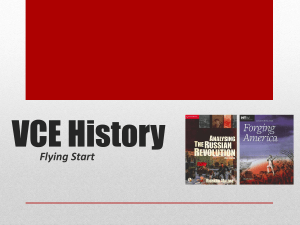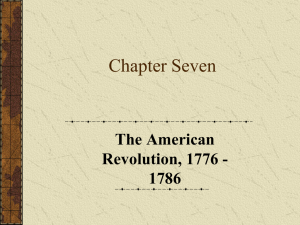8 The America Revolution_ 1775-1783
advertisement
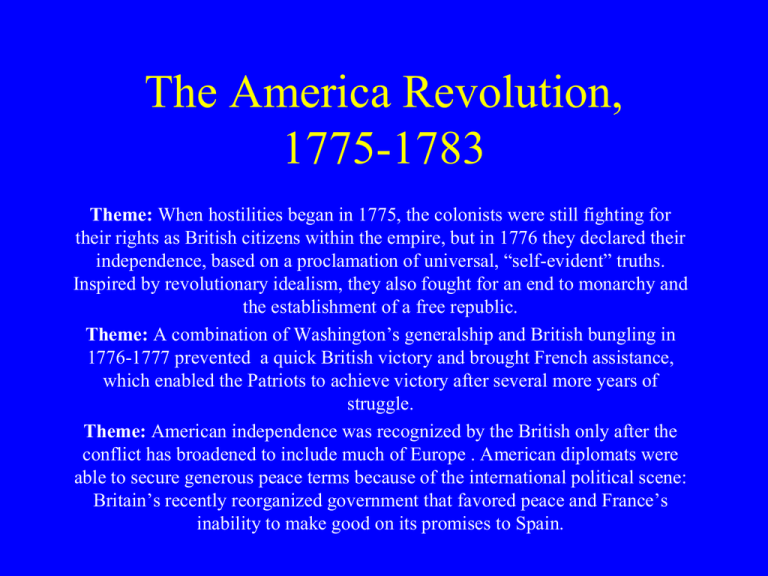
The America Revolution, 1775-1783 Theme: When hostilities began in 1775, the colonists were still fighting for their rights as British citizens within the empire, but in 1776 they declared their independence, based on a proclamation of universal, “self-evident” truths. Inspired by revolutionary idealism, they also fought for an end to monarchy and the establishment of a free republic. Theme: A combination of Washington’s generalship and British bungling in 1776-1777 prevented a quick British victory and brought French assistance, which enabled the Patriots to achieve victory after several more years of struggle. Theme: American independence was recognized by the British only after the conflict has broadened to include much of Europe . American diplomats were able to secure generous peace terms because of the international political scene: Britain’s recently reorganized government that favored peace and France’s inability to make good on its promises to Spain. I. A. Early Colonial Efforts of Reconciliation 2nd Continental Congress, May 1775-1776 1. Continental Army a. G. Washington B. Early Battles 1775-1776 1. Fort Ticonderoga & Crown Point 2. Breed’s Hill 3. Dec. of the Causes and Necessity of Taking Up Arms 1. Olive Branch Petition a. 2. 3. Hessians! Boston Evacuated Moore’s Creek and Charleston II. Turning Point, 1776 A. Declaration of Independence 1. Loyalty to England a. b. 2. Common Sense (500,000 copies!) 1. 3. 4. 5. Transanlantic community Lack colonial unity Independent republic governed by popular consent Richard Henry Lee’s Resolution Authorship Impact a. b. c. Foreign Aid Loyalists (“Tories”) Patriots (“Whigs”) Declaration of Independence by John Trumbull III. War in the North A. General Washington, 1776 1. 2. B. Long Island Trenton and Princeton British Offensive, 1777 1. Battle of Saratoga a. 2. Burgoyne v. Benedict Arnold Battles of Brandywine & Germantown a. Howe v. General Washington 3. C. Valley Forge Diplomacy at Work 1. 2. 3. 4. A Model Treaty Benjamin Franklin (AngloAmerican reconciliation or American-Franco alliance?) Armed Neutrality, 1780 Battle of Monmouth, 1778 IV. War in the West A. Native American Support 1. Chief Joseph Brant 2. Treaty of Fort Stanwix 3. George Rogers Clark B. Privateers 1. John Paul Jones 2. Capture merchant ships V. War in the South, 1778 A. New British Strategy 1. 2. 3. 4. Capture of Georgia Capture of Charleston Capture of SC American riflemen and Nathanial Greene 5. Cornwalis at Yorktown IV. Building a Republic A. Treaty of Paris (1783) 1. American Impact a. b. 2. British recognition Huge boundaries British Impact a. b. Loyalist treatment Pay back loans 3. French Impact a. b. Relieved but perturbed Revolution Map Questions Use the maps and charts in Chapter 8 to answer the following questions (answers are on next slide) 1. 2. 3. 4. 5. 6. 7. 8. Revolution in the North, 1775-1776: Which two British strong points in Canada did the American generals Arnold and Montgomery attack in 1775? New York-Pennsylvania Theatre, 1777-1778: When Washington recrossed the Delaware River before the Battle of Trenton on Dec. 26, 1776, which state did he come from, and which state did he go to? New York-Pennsylvania Theatre, 1777-1778: Which of the three British generals who were supposed to meet near Albany, New York moved in the opposite direction and failed to get to the appointed gathering? Britian Against the World: Besides france, which two European nations directly declared war on Britain during the America Revolution? War in the South, 1780-1781: Name three cities in the South occupied at one time or another by General Cornwallis. Georg Rogers Clark’s Campaign, 1778-1779: Which river did George Rogers Clark moved down as he went to conquer western forts from the British? George Rogers Clark’s Campaign, 1778-1779: Which three British posts did Clark capture? Using maps on p. 144 and 154 as a basis, explain why control of the Hudson River-Lake Champlain Valley was strategically crucial to both the British and the Americans in the war. Answers 1. 2. 3. 4. 5. 6. 7. 8. Montreal and Quebec From Pennsylvania to New Jersey General Howe Spain and Holland Any three of the following; Charleston, Wilmington, Charlottesville, Jamestown, and Yorktown. Ohio Cahokia, Vincennes, and Kaskaskia British would have cut radical New England off from rest of the colonies. Americans needed the supply route from Canadian frontier.

